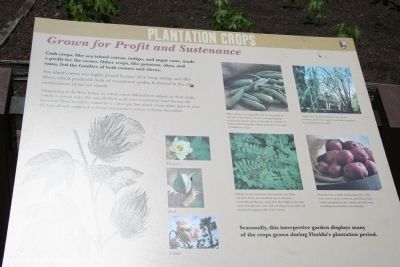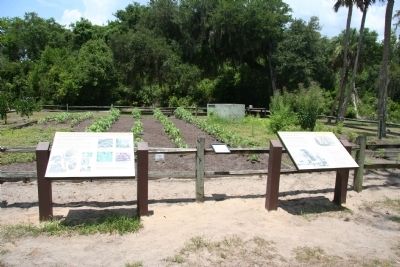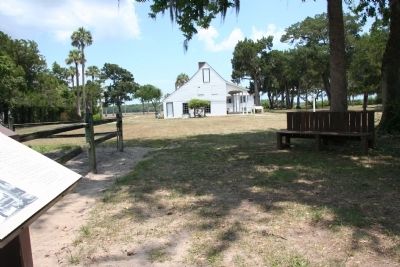Fort George Island near Jacksonville in Duval County, Florida — The American South (South Atlantic)
Plantation Crops
Grown for Profit and Sustenance
Sea island cotton was highly prized because of its long, strong, and silky fibers, which produced cloth of exceptional quality. It thrived in the salty environment of the sea islands.
Originating in the West Indies, sea island cotton differed from upland, or short-staple, cotton in several ways. The smooth black seeds were removed by hand because the luxurious fibers would be ruined by a cotton gin. Sea island cotton plants grew to over six feet tall and continued to bloom and produce cotton well into December.
Okra, African in origin, followed the slave trade to this side of the Atlantic Ocean. Commonly grown in plantation garden plots, it was used in a variety of dishes, including gumbo. Okra continues to be a part of American culture.
Sugar cane was processed into cane syrup, molasses, and brown sugar. It was both consumed here and grown for profit.
Indigo was an important cash crop but very labor intensive. Slaves processed the leaves and stems, eventually producing a deep blue dye. High in demand, cakes of indigo dye were sold and shipped up north and overseas bringing wealth to the owner.
Potatoes were a staple of plantation life. They were easy to grow, nutritious, and filling. Slave cooks used potatoes in a variety of food and items, including stew, biscuits, and chowder.
Erected by National Park Service.
Topics. This historical marker is listed in these topic lists: African Americans • Agriculture • Settlements & Settlers.
Location. 30° 26.353′ N, 81° 26.272′ W. Marker is near Jacksonville, Florida, in Duval County. It is on Fort George Island. Marker can be reached from Palmetto Avenue, 2.1 miles north of Fort George Road. This historical marker is located in a national park. The historical marker is in a very remote area that is reached by traveling a considerable distance on an unpaved dirt road. To get there one must turn north, off of the Florida State Route 1A (Heckscher Road), onto Fort George Road, and then traveling about 0.6 miles to the intersection of Fort George Road and Palmetto Avenue, were you turn north on Palmetto Avenue and travel to the end of this road to reach the historical marker. The turn-off from state route 1A can be identified by the "Kingsley Plantation, Fort George Island Visitor Center" sign that is situated right at the turnoff point. Touch for map. Marker is in this post office area: Jacksonville FL 32226, United States of America. Touch for directions.
Other nearby markers. At least 8 other markers
are within walking distance of this marker. Task System (here, next to this marker); Kingsley Plantation (within shouting distance of this marker); a different marker also named Kingsley Plantation (within shouting distance of this marker); Plantation Slavery (within shouting distance of this marker); a different marker also named Kingsley Plantation (within shouting distance of this marker); Looking Back (within shouting distance of this marker); a different marker also named Looking Back (within shouting distance of this marker); A Very Comfortable Habitation (within shouting distance of this marker). Touch for a list and map of all markers in Jacksonville.
Also see . . .
1. Kingsley Plantation. This is a link to information provided by the National Park Service. (Submitted on February 21, 2011, by Dale K. Benington of Toledo, Ohio.)
2. Kingsley Plantation. This is a link to information provided by Wikipedia, the free encyclopedia. (Submitted on February 21, 2011, by Dale K. Benington of Toledo, Ohio.)
Credits. This page was last revised on February 3, 2023. It was originally submitted on February 7, 2011, by Dale K. Benington of Toledo, Ohio. This page has been viewed 1,038 times since then and 9 times this year. Photos: 1, 2, 3. submitted on February 25, 2011, by Dale K. Benington of Toledo, Ohio.


